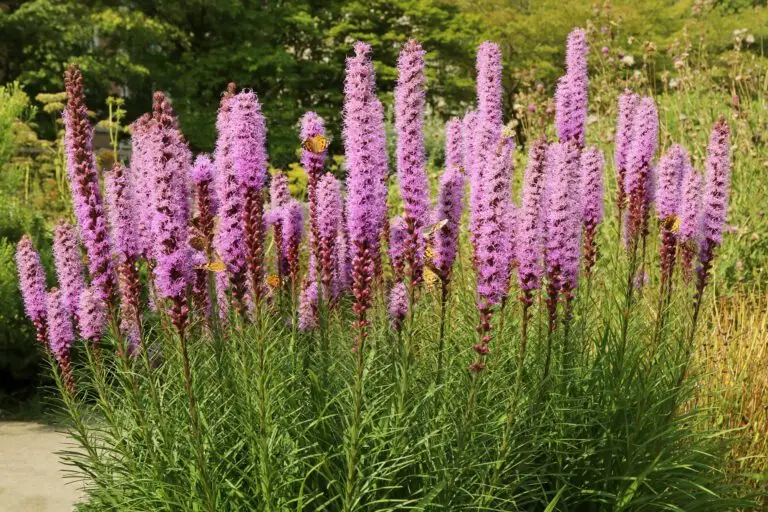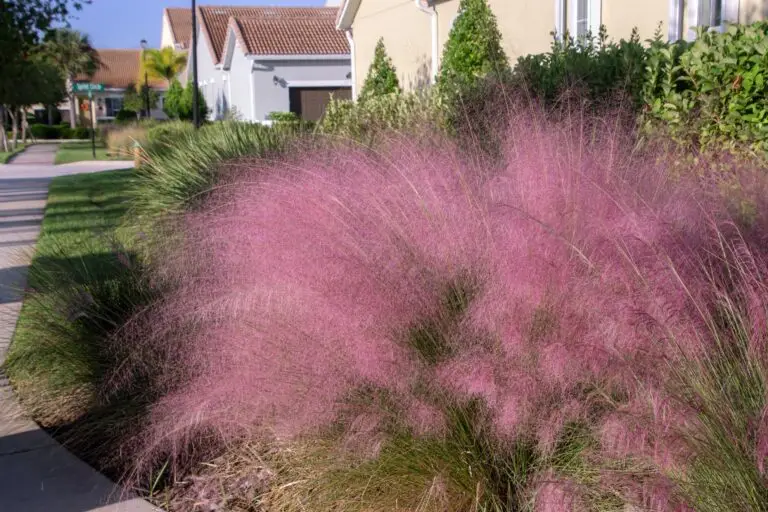What native plants can stand alone and still wow?
Looking for a native plant that will stop people in their tracks and pull out their phones? We’ve got some gardening ideas for you!
Picking a single species of plant and planting in groups is one of the easiest ways to garden. You just need a native plant that can handle the spotlight. Whether you’re looking for grass that turns candy-colored in the fall (Purple Muhly Grass, seen above) or human-sized tall white spires (Culver’s Root, seen below)—scroll on for some showstopper native gardening inspiration.
Gardening can be wonderful and at times also be overwhelming—facing thousands of plant choices can quickly wear our enthusiasm down. We’ve shared a few ways to overcome this feeling, including the Three-Color Garden, Gardens for Butterflies, Gardens for Hummingbirds, Gardens for Birds, and Beautiful Plants with Terrible Names.
There’s another way to garden: pick a single showstopper plant and grow them in a clump or grouping. In this article, let’s focus on a few native plants that can carry a garden all by themselves.
How to plant a single-plant garden
There are lots of ways to plan a garden—you’ve probably seen grids with rounded circles in gardening books before. If that method connects with you—great! Go for that method. Our native plant library will help you find some inspiration.
Gardens can also treat plants with a laser beam focus by planting just a single or a couple of species. This focused method of native gardening puts the shape, texture, and ever-changing color of the plant under a visual microscope. You’ll notice seasonal changes and growth in a whole new way. You’ll also make care as easy as it can get since all you need to pay attention to is a single plant’s light, water, and soil needs.
But not every native can handle this type of attention. You’ll need to pick a single native species that:
- Changes dramatically through the seasons. This one plant needs to be the Cate Blanchet of your garden: singular yet ever changing. Think of the opposite of a boxwood (which never changes!)
- Offers a showstopper moment. Cherry blossom festivals exist for a reason: to celebrate that jaw-dropping, Instagram-worthy moment in a plant’s life. You can have that in your garden too!
- Delivers food and habitat for native birds and wildlife. You can have a gorgeous garden while supporting wildlife. And maybe even start a new hobby as a wildlife photographer!
- Looks great planted in a group. To fill an area with a showstopper moment, ensure you’re planting 5+ plants.
Natives for single-plant gardens
Here are some amazing natives that look great planted in a mass or grouping, and check all three boxes listed above. (Listed in alphabetical order, click on plant links to learn more about each individual species.)
Blazing Star
Think of these as purple lightsabers for your garden. Their bloom period lasts for months. Blazing Stars send up a tall, green stalk in the spring and then cover it with tiny purple, star-like flowers (hence their common name). They are butterfly magnets.
Blazing Stars are drought-tolerant, tall, and love full sun.
Butterfly Weed
Butterfly Weed offers electric orange flowers that look tropical—all while feeding Monarch butterfly babies. Butterfly Weed is one of the 100+ species in the milkweed family. Milkweeds (like Butterfly Weed) are the only plants that monarch caterpillars eat, making it a host plant.
Butterfly Weed has lots of things going for it: it’s easy to plant from seed (and usually flowers the first year), drought-tolerant, and sun-loving. It’s also short (1-2′ tall, on average) making it perfect for borders.
Coneflower
Native coneflowers are one of the easiest, most resilient, and stunning perennials to grow. Planting them in a group only enhances their confident cheerfulness. Coneflowers’ bright, tall, blooms last for 2+ months in the summer. Leave them alone in the fall and winter and let their seed heads turn into bird feeders. Trim them down in the early spring and watch them do it all over again.
Coneflowers are also very easy to plant by seed, making them an affordable group planting option.
Culver’s Root
Tall, elegant spires of white flowers last for six weeks in the late spring to early summer, and cutting them back after flowering can deliver another round of blooms in the fall. This plant should be in heavy landscaping rotation, thanks to its beauty and ability to thrive in a range of areas.
They look great on their own or pair them with a native flower that offers a pop of color (Bee Balm, Blazing Star, and coneflowers are all great options.)
False Blue Indigo
Blue flowers are rare in nature, which makes these stately, tall native plants even more grand. False Blue Indigo starts with bright green leaves in the early spring, then covers tall stalks with indigo flowers by the early summer. The flowers are great for cutting, too.
After the flowers, the green leaves stay and the flowers are replaced with black pods that look like oversized peapods. The combo of leaves + seed pods is stunning. False Blue Indigo is also great for putting nitrogen in the soil, meaning it helps the other plants around it.
False Sunflower
False Sunflowers make bright gardening easy because they are perennials (plant once and they’ll come back, year after year.) This is different from the standard sunflowers, which require replanting via seed every year.
False Sunflowers love full sun, get tall, and are drought-tolerant once they are established. They will be covered in pollinators in the summer and covered in birds in the fall. These are perfect plants for areas where you want something long-lasting with minimal care.
Purple Muhly Grass
Yes, this is a real, native grass that turns purple-pink in the fall. It looks like it was designed in Willy Wonka’s workshop. Before it turns purple, it’s a verdant bright green. Songbirds love their seed tips in the late fall and winter. It’s a cinematic plant, thanks to all these drastic seasonal changes.
Full sun loving, drought-resistant—as easygoing as it gets.
Queen of the Prairie
Here’s another native plant that looks made out of sugar: Queen of the Prairie. These tall native flowers look stunning planted in groups.
They like consistent moisture and full sun—if you have a large area near a stream, river, lake, or pond, consider Queen of the Prairie in the space. Some gardeners call it “slightly aggressive”—meaning it can take over a space via self-seeding or multiplying. Dig some up every couple years to keep it check.
Rattlesnake Master
This native plant has the best name and is perfect for full-sun gardens. Rattlesnake Masters are tall—3-4 feet—and send out round orbs of white flowers that last for 2+ months in the summer. They are a pollinator magnet and look like an outdoor sculpture park when planted in groups.
Rattlesnake Master is also drought-resistant after the first year when it gets established, thanks to its long taproot (which is like a water bottle underground.)
Great shrub and tree pairings
There are SO MANY natives to pair with these singular plant stars! Let’s focus on some shrubs and trees that will deliver decades—or even hundreds of years—of beauty. (Also check out our guide to the Best Native Trees for Front Yards.) Some stellar options include:
Single-plant gardening is not lazy landscaping—it can be a confident, showstopping moment, especially when the right plant is put in the spotlight. Planting native stars like the plants we introduced above can turn a patch of land into an unforgettable vista. Single-plant gardening is also a great way to get started if you’re getting into native gardening—you can easily add more varieties and species in the future (most plants are easily moved!) Happy planting!
Sources
- Nelson, Gil. Best Native Plants for Southern Gardens: A Handbook for Gardeners, Homeowners, and Professionals, (2010).
- Harstad, Carolyn. Go Native! Gardening with Native Plants and Wildflowers in the Lower Midwest. (1999), 209-210.
































